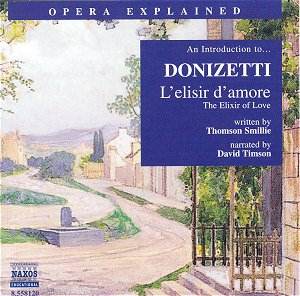I am uncertain who is the bigger bore, a smoker
who has given up or the converted sceptic. I have become so converted
to the ‘An Introduction to…’ series from Naxos, that I was more
than a little miffed not to get the Verdi ‘Forza’ for review.
Verdi’s works constitute the cornerstone of my extensive collection
of opera CDs and also of my equally comprehensive, well thumbed
and read, library. What I enjoy so much are the nuggets of scholarship
that illuminate the ‘Introduction’ section, twenty-seven minutes
spread over seven tracks on this disc. I always hear something
new, or forgotten, and am also made to jump at some musical illustration
of the many that litter the narrative.
Inevitably the ‘Introduction’ on this issue opens
with a sizeable sample of the most popular aria in the opera,
‘Una furtiva lagrima’ (Tr. 1), whilst the emergence of opera and
its relationship with the renaissance follow (Tr. 2) with Monteverdi
and Cavalli being mentioned in the lead up to the great belcantoists
Bellini, Rossini and Donizetti. The names of those two composers
are drawn into a discussion of ‘movements’. The discussion spreads
into art and literature of different periods from the renaissance
to the romantic. The narrative returns to the age of bel canto
via musical illustrations drawn from Naxos’s recording of Rossini’s
‘Barber of Seville’. This provokes a discussion of Rossini and
Bellini (Tr. 3) with interesting musical illustrations of recycling
of overtures and arias. An example of the latter made me sit up,
being from mezzo to tenor. I ‘knew’ the piece but the parallel
had never really hit me before hearing these juxtaposed musical
excerpts. There is also mention of Rossini’s serious operas whilst
Bellini is eulogized as the personification of the perfect belcantoist.
After mention of Verdi, Puccini and verismo, with extracts from
the ‘Forza’ overture and ‘Nessun dorma’ we return to Donizetti
with mention of the variety and number of his works before focusing
on Lucia (Tr. 5) with the sextet from a Naxos ‘Historical’ issue
and a modern version of the ‘Mad Scene’ as musical illustration.
Tribute is paid to Mayr for his support of Donizetti’s education
and his works and his influence on the evolution of the crescendo
(Tr. 6) that we often attribute to Rossini who used it so effectively.
The introduction concludes with further mention of Donizetti’s
extensive oeuvre and ‘opera buffa’, with a sample of Verdi’s Falstaff,
before considering the origins of ‘L’elisir’. The remaining fifty
minutes of the disc take the listener through the plot of the
opera with the many brief, but relevant musical illustrations,
coming from Naxos’s own complete recording.
Erudite, informative and entertaining for the
opera enthusiast or first timer.
Robert J Farr
